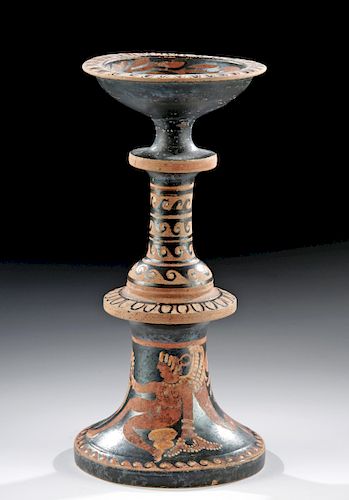Greek Paestan Red-Figure Thymiaterion w/ TL Test
Lot 35b
About Seller
Artemis Fine Arts
686 S Taylor Ave, Ste 106
Louisville, CO 80027
United States
Selling antiquities, ancient and ethnographic art online since 1993, Artemis Gallery specializes in Classical Antiquities (Egyptian, Greek, Roman, Near Eastern), Asian, Pre-Columbian, African / Tribal / Oceanographic art. Our extensive inventory includes pottery, stone, metal, wood, glass and textil...Read more
Estimate:
$5,000 - $8,000
Absentee vs Live bid
Two ways to bid:
- Leave a max absentee bid and the platform will bid on your behalf up to your maximum bid during the live auction.
- Bid live during the auction and your bids will be submitted real-time to the auctioneer.
Bid Increments
| Price | Bid Increment |
|---|---|
| $0 | $25 |
| $300 | $50 |
| $1,000 | $100 |
| $2,000 | $250 |
| $5,000 | $500 |
| $10,000 | $1,000 |
| $20,000 | $2,500 |
| $50,000 | $5,000 |
| $100,000 | $10,000 |
| $200,000 | $20,000 |
About Auction
By Artemis Fine Arts
Sep 26, 2019
Set Reminder
2019-09-26 10:00:00
2019-09-26 10:00:00
America/New_York
Bidsquare
Bidsquare : Exceptional Day 1: Antiquities & Asian Art
https://www.bidsquare.com/auctions/artemis-gallery/exceptional-day-1-antiquities-asian-art-4437
Day 1 of an important 2-day auction featuring exceptional, museum-worthy examples of Egyptian, Greek, Etruscan, Roman, Viking, Russian, Near Eastern, as well as Asian Art from China, Japan, Thailand, Vietnam, Burma and India. Artemis Fine Arts info@artemisgallery.com
Day 1 of an important 2-day auction featuring exceptional, museum-worthy examples of Egyptian, Greek, Etruscan, Roman, Viking, Russian, Near Eastern, as well as Asian Art from China, Japan, Thailand, Vietnam, Burma and India. Artemis Fine Arts info@artemisgallery.com
- Lot Description
Magna Graecia, South Italy, Paestan, ca. 4th to 3rd century BCE. A stunning terracotta thymiaterion (incense burner) decorated via the red-figure technique w/ fugitive white and yellow pigments. Adorning the base is a winged Erote sitting upon a rocky outcrop and holding a tambour in the raised hand an another wreath-like attribute in the lowered hand. On the opposite side is an elegant stylized palmette. Underscoring these elements is a band of continuous wave motifs. The central tier of the thymiaterion features a band of tongues followed by four wave bands. Finally, the footed bowl/receptacle above presents a band of tongue motifs on the rim, a laurel leaf garland bordering the bowl and surrounding a three-legged triskelion motif in the tondo. An impressive example replete with an elaborate decorative program and an elegant form. Size: 4.125" in diameter at base x 8.25" H (10.5 cm x 21 cm)
Thymiateria (derived from a Greek word meaning "to smoke") were ancient censers or incense burners used for religious or spiritual purposes such as sacrifices or offerings to the deities. Although the term originated for ancient Greek forms, it is also used for censers created by other ancient peoples such as the Etruscans and the Phoenicians. Interestingly, thymiateria are still used today in Greek Orthodox churches.
This piece has been tested using thermoluminescence (TL) analysis and has been found to be ancient and of the period stated. A full report will accompany purchase.
Provenance: private J.H. collection, Beaverton, Oregon, USA; ex-Tom Cederlind collection, Portland, Oregon, USA
All items legal to buy/sell under U.S. Statute covering cultural patrimony Code 2600, CHAPTER 14, and are guaranteed to be as described or your money back.
A Certificate of Authenticity will accompany all winning bids.
We ship worldwide and handle all shipping in-house for your convenience.
#149627There is a TL hole in the base and one to the underside of the upper footed bowl. Minute nicks/chips to rim of bowl with possible inpainting to decoration around the rim. Nicks to periphery of the base. Pressure fissures to bowl. Normal surface wear with scuffs and minute pigment loss. Scattered deposits most visible on buff clay on exterior and interior/underside but also visible on the Erote, palmette, and other decorative motifs. Black glaze has developed a gorgeous iridescence.Condition
- Shipping Info
-
All shipping is handled in-house for your convenience. Your invoice from Artemis Gallery will include shipping calculation instructions. If in doubt, please inquire BEFORE bidding for estimated shipping costs for individual items.
-
- Buyer's Premium



 EUR
EUR CAD
CAD AUD
AUD GBP
GBP MXN
MXN HKD
HKD CNY
CNY MYR
MYR SEK
SEK SGD
SGD CHF
CHF THB
THB
















